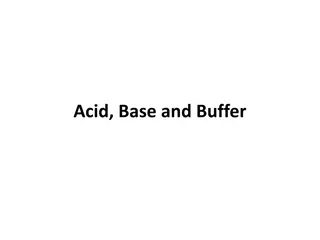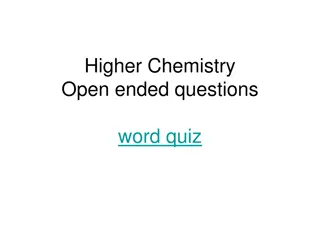Understanding Buffers in Chemistry
The concept of buffers in chemistry plays a crucial role in maintaining stable pH levels in solutions. Buffers consist of components that neutralize acids and bases, helping prevent drastic pH changes. Weak acids or bases are ideal buffer components due to their ability to react with both acids and bases efficiently. The composition and ratios of the conjugate acid/base pair determine the effectiveness of a buffer in resisting pH changes. This summary delves into the importance and function of buffers in chemical solutions.
Download Presentation

Please find below an Image/Link to download the presentation.
The content on the website is provided AS IS for your information and personal use only. It may not be sold, licensed, or shared on other websites without obtaining consent from the author. Download presentation by click this link. If you encounter any issues during the download, it is possible that the publisher has removed the file from their server.
E N D
Presentation Transcript
Saturday School: 10-11ish Monday: Cold Call Quiz
I have two beakers Beaker 1 1 L of pure water Beaker 2 1 L of human blood I pour 5 mL of NaOH in the pure water and the pH goes from 7 up to 13.2 I pour 5 mL of NaOH into the blood and it goes from a pH of 7.2 to 7.3
I have the same two beakers Beaker 1 1 L of pure water Beaker 2 1 L of human blood I pour 5 mL of HCl in the pure water and the pH goes from 7 up to 2.2 I pour 5 mL of NaOH into the blood and it goes from a pH of 7.2 to 7.1
A buffer is any solution that resists changes in pH Two components of a buffer: 1. A component that neutralizes an acid 2. A component that neutralizes a base A weak acid or a weak base are capable of creating a buffer because they have both of these components, but a strong acid or base cannot create a buffer.
A weak acid or base make an excellent buffer because they have a component that can react with an acid and a component that can react with a base. CH3COOH + H2O CH3COO- + H+ base! Therefore, reacting each component produces a part of the equilibrium and little change in pH is observed! Can react with a Can react with an acid!
The best buffers have close to equal concentrations of the conjugate acid/base pair. We can think about the Ka expression for a weak acid Ka=[H+][A-] [HA] [H+] = Ka[HA] [A-] Therefore, pH is determined by the ratio of conjugate acid/base pair and the value of Ka. As long as the change in ratio of [HA]/[A-] is small, the change in pH will be small.
Adding base to a buffer shows minimal change Adding base to a neutral solution causes huge changes
Could each of the following solutions can be classified as buffer systems? Why/why not? 1. KH2PO4/H3PO4 2. NaClO4/HClO4 3. C5H5N/C5H5NHCl (C5H5N is a base)
Students explore using http://www.mhhe.com/physsci/chemistry/ess entialchemistry/flash/buffer12.swf
Calculate the pH of a buffer that is 0.12 M lactic acid and 0.10 M sodium lactate. The Ka for lactic acid is 1.4 x 10-4
Calculate the pH of a buffer composed of 0.12 M benzoic acid and 0.20 M sodium benzoate. The Ka for the solution is 6.4 x 10-5
The pH at which any buffer works most effectively is when pH = pKa This is known at the equivalence point Buffers usually have a useable range within 1 pH unit of the pKa

























